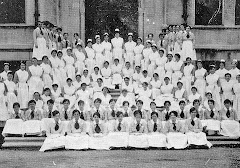As stated for a plan of action, an editorial was written to the Daily News Record of Harrisonburg, VA. Nothing has been heard yet as to whether the editorial would be published. The editorial was written to bring awareness to people of this community as to possible reasons for the nursing shortage and ways that this bill addresses those issues.
This is a copy of the editorial sent to the Daily News Record:
"The Nursing Education Opportunities Act is a bill amend title VIII of the Public Health Service Act to expand the nurse student loan program, to establish grant programs to address the nursing shortage, to amend title VII of the Higher Education Act of 1965 to provide for a nurse faculty pilot project, and for other purposes.
As a nursing student at James Madison University, it is seen firsthand the struggle among peers excited about the nursing program work extremely hard their first two years at the University to make sufficient grades (and G.P.A.) to become eligible for the program. Once eligible and accepted to the program (approximately 60-70 students are selected per semester), nursing students must pay for overly priced textbooks, JMU nursing scrubs and uniforms attire, lab fees, gas monies to and from clinicals, class dues, and tuition itself. With tuition rising each year, students in the nursing program are having a harder time being able to afford the education it requires to achieve their dream job. With grants and students loans that come with this bill, more nursing students will be able to achieve their goals.
Not only is the nursing program expensive for students, but it is also highly competitive. Prospective students often have to wait a semester or two to be accepted and start the program. This problem could be solved with grant money to allow the hiring of qualified nursing professors. Of course, there are not many professors available right now because there is hardly an incentive to return to college to teach.
To discuss the nursing shortage: this bill would pave the way for allowing more qualified students to be accepted to nursing programs, which is a step in the right direction for lessening this problem. Also, with this bill, there would be an incentive for retired nurses to pursue higher education to become nursing faculty at universities, such as JMU, who are in constant need of professors.
In support of this bill, it is encouraged to research this issue as it is not discussed often in the presidential debates, yet is very important and affects everyone. For more information on this bill, please visit: http://nsgforchange.blogspot.com/"
Need For Change
It is evident that there a national shortage of nurses. Estimated projections show a dismal future if no attempts are made to alleviate the pressures that are driving nurses out of the profession and accommodate increasing student interest and enrollment.
The Health Resources and Services Administration (HRSA) estimates the supply of nurses in America will fall 36 percent below requirements by the year 2020, and that RNs leaving the workforce will outpace those entering the profession by 2016. According to The American Association of Colleges of Nursing (AACN) survey, data from 2006-2007 showed that nursing colleges and universities denied admission to 42,866 qualified applicants due to insufficient faculty (71%), and full admission seats(74%). Additionally, a lack of funding forced the HRSA to turn away 82 percent of the applicants for the Nurse Education Loan Repayment Program (NELRP), and another 94 percent for the Nursing Scholarship Program.
The Health Resources and Services Administration (HRSA) estimates the supply of nurses in America will fall 36 percent below requirements by the year 2020, and that RNs leaving the workforce will outpace those entering the profession by 2016. According to The American Association of Colleges of Nursing (AACN) survey, data from 2006-2007 showed that nursing colleges and universities denied admission to 42,866 qualified applicants due to insufficient faculty (71%), and full admission seats(74%). Additionally, a lack of funding forced the HRSA to turn away 82 percent of the applicants for the Nurse Education Loan Repayment Program (NELRP), and another 94 percent for the Nursing Scholarship Program.
Subscribe to:
Post Comments (Atom)





No comments:
Post a Comment